After reading the first part of the series you might have decided that you are interested in the XC Class. Comparing performance of three of the top contenders in the class, we see how different they are, and how much difference it makes.
Tech specs
Almost everyone wants to know about performance. Can these figures tell us anything?
|
Wing |
Advance Iota 26 |
Nova Mentor 4 S |
Skywalk Chili 3 S |
Skywalk Chili 3 M |
|
Class |
XC |
XC |
XC |
XC |
|
Weight range |
75-100 kg |
80-100 kg |
80-100 kg |
90-110 kg |
|
Flat area m2 |
26.0 |
26.1 |
26.9 |
28.9 |
|
Aspect ratio |
5.5 |
5.4 |
5.5 |
5.5 |
|
Proj. area m2 |
21.6 |
22.3 |
22.9 |
24.5 |
|
Proj. A/ratio |
3.9 |
4.0 |
4.1 |
4.1 |
|
Proj. span m |
9.2 |
9.4 |
9.7 |
10.0 |
|
Line length m |
7.5 |
6.9 |
7.2 |
7.4 |
|
Cells |
59 |
55 |
51 |
51 |
|
If flown at |
97.0 kg |
97.0 kg |
97.0 kg |
109.0 kg |
|
Wing load/m2 |
4.49 |
4.35 |
4.24 |
4.49 |
Looking at the specs (for a pilot of the same weight) I might expect the Iota to be slightly faster due to the higher wingloading, and the Chili 3 should have better glide due to projected aspect ratio. But the Mentor 4 and Iota have thinner lines so their glide might be just as good. Then there's the profile shape, wingtip 'toe angle' (the angle of the wingtips relative to the whole span of the whole wing i.e. are the wingtips rotated forwards ('toe-in'), rearwards ('toe-out'), or straight (neither 'toe-in' or 'toe-out'), relative to the whole span of the wing), line consumption, and even the stitching style and fabric billow that reduces the real area. You can do this kind of guesswork all day. There are too many factors that interact in the complex science of aerodynamics.
But we can test them in the air, right?
Unfortunately, not.
Moving air
Here's the big problem: you're unlikely to fly far in still air, and in 'moving air' thermals make accurate results impossible. The video showed an Icepeak 6.23 vs an Icepeak 6.23 gliding beside each other. One lost 50m altitude in less than 20 seconds. It doesn't need to be this dramatic to upset a glide angle comparison: it could be just 0.1m/s sink, which you wouldn't be able to identify as an air current - you might confuse it for a lack of wing performance.

When comparing performance of the Icepeak 6 vs Mistral 7, gliding close, it looks like the lower class wing has more performance! The longer the glide the more averaging removes inequalities but it's still possible to glide for 10km along a lifty line and make a worse glider appear to be the better one.
Glide comparisons
In the video I am 97kg on the Iota 26, Carlo is flying at 94.5 on the Mentor 4 S and John is 109 on Chili 3 L. John's on a larger size wing, with higher efficiency. I am in a sit-up-and-beg harness, with more drag. Carlo has the lowest wing loading. Already we are not comparing apples with apples.
We are supported by a gas. It only needs to have a few swirls to disrupt the results. Nothing is measuring the unequal movements of the airmass we are gliding through. You're also only seeing the performance of one unit of a particular make and model, which doesn't allow for manufacturing variations.
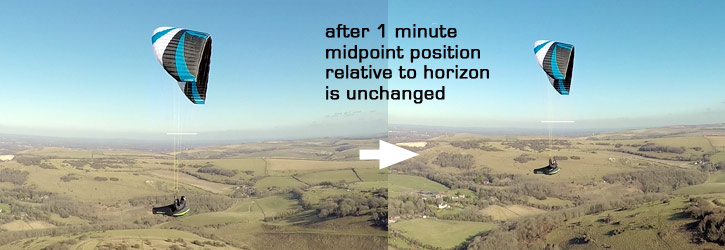
Speeding up one minute of gliding, we can see the start and end position are very similar between that Chili3 and this Iota in that bit of air. No conclusions can be drawn, apart from the fact that that there is very little difference between all current wings within a class. So why the big fuss about performance?
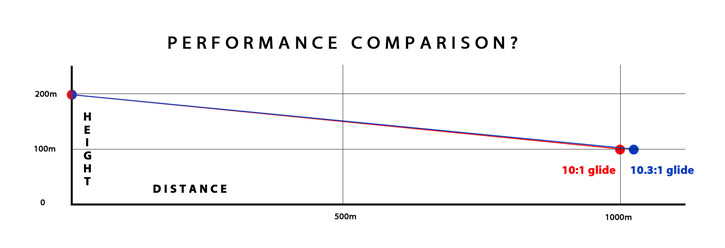
Let's look at this another way. What kind of difference are you looking for? I'd be interested in a 0.3 difference in glide ratio, so one wing on 10 and the other on 10.3. But in reality, this equates to 3m height gain or 30m ahead after 1km of undisturbed gliding. That's hard to see when you are constantly moving.
For definitive data you'd need at least 10 glides of longer distance, but unless the air is calm you'll have too much interference to get repeatable results. When you introduce moving air you cannot separate the disturbance from the performance. What you see is a single data point on a scatter graph of performance.
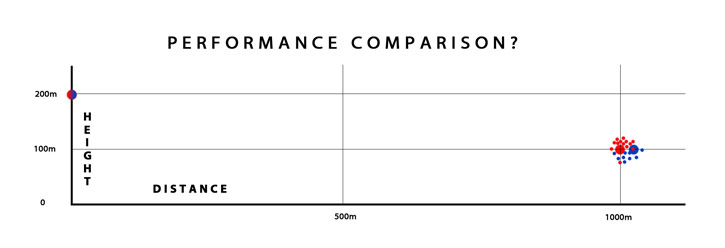
'Climb rate tests' are even more questionable. Minor changes in turn rate and style result in different climb rates. The lift distribution is unequal in most thermals and nothing is measuring the climb rate of the air the wing is being subjected to. The highest agility turn often wins the day, not the best climb rate and this depends on pilot intervention. The wings themselves are so close you'll go blind trying to see the difference.
Cross country comparisons
On an XC flight, we mostly fly alone, we make thousands of choices and each diversion puts us on a different line. When we do pull up beside another pilot, we don't know the wing size, wing loading, how much speedbar is being used or how old the wing is. The pilot will be in a difference harness, and he'll do slightly different things to control his wing. We never get to verify our wing performance in a fair comparison. If you're not aiming for first place in international competitions, don't worry about the wing's performance: if you're on something current, it is about the same.
.jpg)
Handling is much more interesting, because it governs your ability to put the wing where you want it and to feel hints of where the best lift is.
Stability should concern you too, because it builds your confidence and saves you from your mistakes.
Luckily, these are things which good reviewers can identify fairly fast. At Flybubble we test all of our demo wings to learn about their characters.
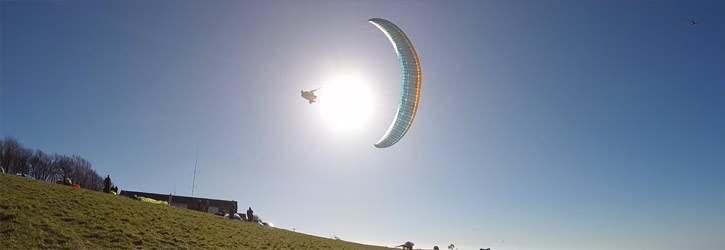
The Iota is mostly about 'handling', the brakes feel medium and linear but give a quick change of direction. The feedback from the wing is smoothened yet gives you a feeling of being connected with the air. A small criticism we could make is that the Iota's back risers pull the tip cascade as well, which makes strong wind control tricky unless you reach into the C lines.
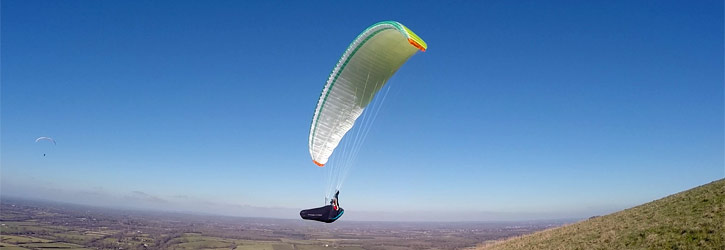
The Mentor 4 is all about a 'secure feel'. The brakes are medium to heavy, they grab at the air and the feedback from the wing is low and dampened. Pilots who prefer a more responsive and energetic wing might find themselves wanting. Out of the three, you'll be bounced around the least on the Mentor if flying in rough air is your thing.
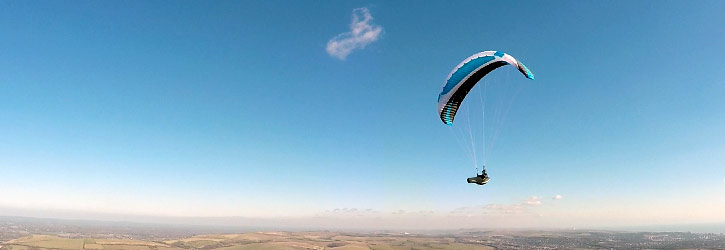
The Chili 3 has a 'performance' character: the brakes feel light and need a wrap because of long travel. The feedback from the wing is moderate, subtle and slightly disconnected, somewhere between the Iota and Mentor. The Chili 3 can get too lively for pilots with slow reactions, it likes to pitch and needs active piloting because it is spicy.
In conclusion
We could add much more. Little details add up to make a big difference in your progression.
If the salesman focuses on the performance of the wing he's selling and not on you, there's a good chance you'll be getting the wrong wing.
The right wing depends so much on the pilot. We don't produce lists of 'best' wings in each class, because they don't exist until the pilot has been put into the equation. We need to speak to you so we can match the wing with your unique situation.
Don't be misled by a video showing one data point on a scatter graph of performance. Talk to expert pilots with experience on the wings you're considering. There's more to wing comparisons than straight line gliding. There's more to becoming a top pilot than buying a wing.
We hope this article and accompanying video (see below) help you understand comparing the performance of wings.
If you need good advice based on a broad range of brands, come on over to our website and see what we have to offer. We are expert at matching pilots with the right gear.
Check out the current range of wonderful wings we have to offer.
How to Choose the Right Paraglider Part Two: Comparing Performance video
Brought to you by Flybubble
Like what we do? The best way to support us is to buy gear from us. Also recommend us and be a patron. Thank you!

